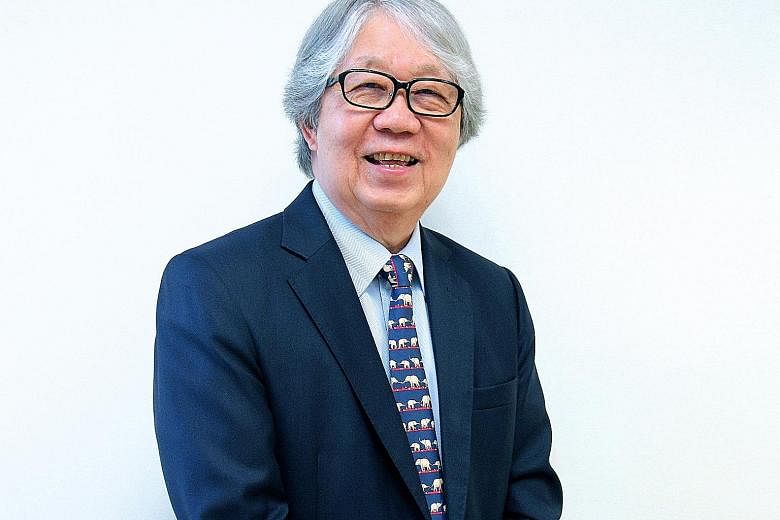Singapore and China have just celebrated the 25th anniversary of the establishment of diplomatic relations between the two countries. It is, therefore, an opportune moment to take stock of this important relationship.
The People's Republic of China was established in 1949. The Republic of Singapore was established in 1965. From 1965 until the late 1970s, political relations between China and Singapore were unfriendly and acrimonious. China, under Chairman Mao, was a revolutionary country.
It sought to export revolution to South-east Asia and gave both material and moral support to the communist parties and their armed struggles. The leaders of Singapore were often condemned as the running dogs of the imperialists.
Things began to improve following the successful visits to China by Singapore's Foreign Minister, Mr S. Rajaratnam, in 1975 and by Singapore's Prime Minister, Mr Lee Kuan Yew, in 1976. Mr Lee called on Chairman Mao shortly before he passed away that year.
In 1978, Mr Deng Xiaoping, the new de facto leader of China, visited Thailand, Malaysia and Singapore. I believe that his heart-to-heart talk with Mr Lee in Singapore convinced him to change China's policy towards the region. In his memoirs, Mr Lee recounted that exhortations for the overthrow of governments in South-east Asia, from broadcasting stations in China, stopped a year after his meeting with Mr Deng in Singapore in November 1978.
Golden period of Asean-China ties
As a result of Mr Deng's wise leadership and policy, China's relations with Singapore and the region gradually improved. The acrimony and mistrust of the Mao era were replaced by goodwill and growing mutual trust. China offered Asean a free trade agreement so that Asean could benefit from China's growing prosperity.

Today, China is Singapore's and Asean's largest trading partner. China is a significant provider of official development assistance to the new members of Asean. China has also become the largest source of tourists to the Asean countries.
China has supported Asean's centrality in regional organisations. China has always shown respect to Asean by sending high representatives to its meetings with Asean and other Asean-led meetings. In addition, China hosts annually a major Asean trade show and a summit meeting with Asean's leaders in Nanning, in Guangxi province. In 2002, China signed the Declaration of Conduct in the South China Sea.
To sum up, I would say that of Asean's 10 dialogue partners, Asean's cooperation with China is the most substantive.
I would also describe the period 1979 to 2009 as the golden period of Asean-China relations.
Relations since 2009
Relations between Asean and China have, unfortunately, become less smooth since 2009. I would attribute this development to two factors.
The first is the disputes in the South China Sea between China and four Asean claimant countries - Brunei, Malaysia, the Philippines and Vietnam. In 2009, China submitted to the United Nations a map of the South China Sea with a nine-dash line. The U-shaped nine-dash line claims almost all of the South China Sea. The map has caused a lot of misunderstanding because China has not adequately explained the legal significance of the nine-dash line or the precise nature of its claims.
Although Asean, as a group, does not take sides on the merits of the claims, it has taken a group position on six governing principles.
These include the principle that the disputes should be settled by peaceful means without the use of force or threat to do so.
Another principle is that the disputes should be settled strictly in accordance with international law, including the UN Convention on the Law of the Sea.
In view of this, it is not possible for Asean to accept China's demand that Asean should not take a group position on the South China Sea. After all, the South China Sea is part of Asean's neighbourhood. Asean wants peace and the rule of law to prevail in the South China Sea. At the same time, Asean wants good relations with China.
More assertive diplomacy
The second factor is that China's charm offensive has been replaced by a new paradigm of assertive diplomacy. In recent years, Chinese diplomats in the different Asean capitals have changed from being humble and respectful to being demanding and assertive. This change has been noticed by the Asean countries.
Singapore is currently the Asean coordinator of Asean-China relations. Singapore will do its best to keep the relationship on an even keel. However, we will only succeed if China acts with wisdom and self-restraint towards Asean, bearing in mind the asymmetry of size and power.
The two sides, should, however, not allow the differences on the South China Sea to overshadow the positive Asean-China agenda or to prevent them from cooperating in the many areas where their interests converge.
Three issues
I would like to discuss three issues which could affect the good bilateral relationship between Singapore and China.
SINGAPORE IS NOT A CHINESE NATION
The first is the perception by some of our friends in China of Singapore as a Chinese nation. Although the Chinese constitute nearly 75 per cent of our population, Singapore is not a Chinese nation but a multiracial nation. This misperception was also shared by some of our friends in the West, who used to refer to Singapore as the "Third China". It is because of such misperceptions that Singapore decided to be the last of the five founding members of Asean to establish diplomatic relations with China.
PRIMACY OF ASEAN
The second issue is that Singapore is a sovereign and independent country located in the heart of South-east Asia. Our destiny lies in South-east Asia. This is why we attach such great importance to our regional organisation, Asean.
Our Chinese friends should, therefore, understand that our relations with China will inevitably be affected by China's relations with the region and with Asean.
RELATIONS WITH MAJOR POWERS
The third issue is Singapore's relations with the major powers. Some of our friends in China do not understand our foreign policy. They feel that given the ethnic composition of our population and our growing economic stake in China, we should move closer to China. As a small country, we wish to be close to all the major powers but not to be aligned with any of them.
We try to be relevant and useful to each of the major powers. We do not wish to take sides in their disputes with one another. We do not regard international relations as a zero-sum game and we hope that we will never have to choose sides. One objective of our foreign policy is to give Singapore maximum political and economic space.
Excellent bilateral relations
Singapore and China enjoy excellent relations. These are founded on very substantial economic interests, a high level of mutual trust between our leaders, extensive cooperation in many areas, a thick network of institutional linkages at the national and provincial levels and strong ties between our two peoples.
It is quite remarkable that, since 2013, Singapore has become the largest foreign investor in China. It is also remarkable that, since 1992, over 55,000 Chinese cadres and officials have attended various programmes in or made study visits to Singapore.
As a sign of Singapore's continued confidence in the Chinese economy, the two governments recently concluded an agreement to launch a third flagship project in the western region of China, centring on Chongqing. Singapore was an early supporter of the Asian Infrastructure Investment Bank and the One Belt, One Road proposal.
Last year, Singapore and China celebrated the 25th anniversary of the establishment of diplomatic relations between our two countries. The presidents of Singapore and China exchanged visits. During President Xi Jinping's visit last November, the two governments agreed to elevate our relationship to an "all-round cooperative partnership progressing with the times". I am confident that our excellent bilateral relationship will be taken to an even higher peak in the years ahead.
- The writer is co-chairman of the China-Singapore Forum.



